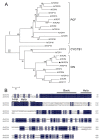Heterologous Expression of GbTCP4, a Class II TCP Transcription Factor, Regulates Trichome Formation and Root Hair Development in Arabidopsis
- PMID: 31546783
- PMCID: PMC6771151
- DOI: 10.3390/genes10090726
Heterologous Expression of GbTCP4, a Class II TCP Transcription Factor, Regulates Trichome Formation and Root Hair Development in Arabidopsis
Abstract
Two class I family teosinte branched1/cycloidea/proliferating cell factor1 (TCP) proteins from allotetraploid cotton are involved in cotton fiber cell differentiation and elongation and root hair development. However, the biological function of most class II TCP proteins is unclear. This study sought to reveal the characteristics and functions of the sea-island cotton class II TCP gene GbTCP4 by biochemical, genetic, and molecular biology methods. GbTCP4 protein localizes to nuclei, binding two types of TCP-binding cis-acting elements, including the one in its promoter. Expression pattern analysis revealed that GbTCP4 is widely expressed in tissues, with the highest level in flowers. GbTCP4 is expressed at different fiber development stages and has high transcription in fibers beginning at 5 days post anthesis (DPA). GbTCP4 overexpression increases primary root hair length and density and leaf and stem trichomes in transgenic Arabidopsis relative to wild-type plants (WT). GbTCP4 binds directly to the CAPRICE (CPC) promoter, increasing CPC transcript levels in roots and reducing them in leaves. Compared with WT plants, lignin content in the stems of transgenic Arabidopsis overexpressing GbTCP4 increased, and AtCAD5 gene transcript levels increased. These results suggest that GbTCP4 regulates trichome formation and root hair development in Arabidopsis and may be a candidate gene for regulating cotton fiber elongation.
Keywords: TCP transcription factor; root hair development; sea-island cotton; trichome formation.
Conflict of interest statement
The authors declare no conflict of interest.
Figures







Similar articles
-
Heterologous overexpression of the GbTCP5 gene increased root hair length, root hair and stem trichome density, and lignin content in transgenic Arabidopsis.Gene. 2020 Oct 20;758:144954. doi: 10.1016/j.gene.2020.144954. Epub 2020 Jul 16. Gene. 2020. PMID: 32683079
-
The sea-island cotton GbTCP4 transcription factor positively regulates drought and salt stress responses.Plant Sci. 2022 Sep;322:111329. doi: 10.1016/j.plantsci.2022.111329. Epub 2022 Jun 3. Plant Sci. 2022. PMID: 35667469
-
A signal R3-type, CAPRICE-like MYB transcription factor from Dendrobium nobile controls trichome and root-hair development in Arabidopsis.Plant Sci. 2023 Dec;337:111878. doi: 10.1016/j.plantsci.2023.111878. Epub 2023 Sep 29. Plant Sci. 2023. PMID: 37777017
-
Updates on molecular mechanisms in the development of branched trichome in Arabidopsis and nonbranched in cotton.Plant Biotechnol J. 2019 Sep;17(9):1706-1722. doi: 10.1111/pbi.13167. Epub 2019 Jun 11. Plant Biotechnol J. 2019. PMID: 31111642 Free PMC article. Review.
-
Regulatory mechanisms of trichome and root hair development in Arabidopsis.Plant Mol Biol. 2024 Dec 30;115(1):14. doi: 10.1007/s11103-024-01534-w. Plant Mol Biol. 2024. PMID: 39739145 Review.
Cited by
-
GrTCP11, a Cotton TCP Transcription Factor, Inhibits Root Hair Elongation by Down-Regulating Jasmonic Acid Pathway in Arabidopsis thaliana.Front Plant Sci. 2021 Nov 22;12:769675. doi: 10.3389/fpls.2021.769675. eCollection 2021. Front Plant Sci. 2021. PMID: 34880892 Free PMC article.
References
-
- Ni Z., Li B., Neumann M.P., LÜ M., Fan L. Isolation and expression analysis of two genes encoding cinnamate 4-hydroxylase from Cotton (Gossypium hirsutum) J. Integr. Agric. 2014;13:2102–2112. doi: 10.1016/S2095-3119(13)60643-7. - DOI
Publication types
MeSH terms
Substances
LinkOut - more resources
Full Text Sources

